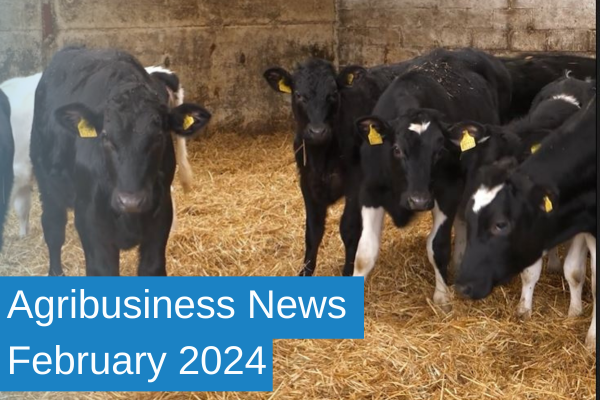Agribusiness News February 2024 – Inputs: Calf Management
1 February 2024Calves are the future!
The dairy heifer calves born today will be the milking herd in two years’ time. However, a recent study using BCMS data has shown that the calf mortality rate in the United Kingdom in dairy bred calves was 6% which is around double the industry target of <3%.
Combine this with the percentage of dairy heifer calves that don’t reach 1st calving, estimated at 15%, and already there is a lot of lost potential in the system. Therefore, it is important that we get the management of calves right to minimise any losses.
From the word go….
One of the most vital stages of a calf’s life is ensuring that it consumes colostrum as soon as possible after birth. Not only is colostrum an energy source for the calf but is also contains antibodies which are vital to prevent disease in those first stages of life.
A survey of Scottish dairy calves showed that 14% had failure of passive transfer (FPT) due to poor absorption of colostral immunoglobulins. Calves with FPT have higher incidences of morbidity and mortality as well as long-term effects on productivity.
A European study estimated the cost of FPT to be €60 per calf (~ £52, Jan 24). One of the many potential reasons that FPT can occur can be down to a delay in feeding colostrum.
As it has been shown that a delay in colostrum feeding also delays the colonisation of the beneficial bacteria in the intestines of the calf. Therefore, it is important to remember the 3 Q’s of colostrum:
- Quality
- Quantity
- Quickly
In recent years there has been an increase in the number of dairy farmers testing the quality of colostrum produced on their farm and there are a number of practical methods that can be used, one being a Brix refractometer. Calves should be fed colostrum with a Brix reading ≥22%.
In terms of quantity, the general rule of thumb is 10% of bodyweight, which can equate to 3-4 litres. However, it is also vital to ensure that the colostrum being fed to the calf is as clean as possible (i.e. minimise bacterial contamination and proliferation) and as quietly as possible to maximise the rate of absorption.
Following good colostrum management procedures should be regarded as ‘money in the bank’ when it comes to calf rearing!
Maintaining good health is always a goal throughout the pre-weaning period for calves. The two main diseases amongst calves are diarrhoea and respiratory disease.
An episode of diarrhoea has an estimated cost of £58 and respiratory disease £43 per case minimum. There has been a lot of research conducted into the long-term consequences of having respiratory disease as a calf.
One such area has been in milk production in first lactation. A meta-analysis of the various research studies has shown that respiratory disease as a calf will lead to a 121.2kg reduction in milk production in first lactation (range: 70-525kg). Based on a farmgate milk price of 35p/litre, this is already approx. £42 lost income in that lactation.
What about feeding?
After colostrum has been fed to the calf, there is great debate as to what to feed from that point onwards. Some people will feed whole milk whilst others will feed milk replacer until weaning.
There is also now a growing interest in feeding transition milk (i.e. the milk from the 2nd, 3rd,4th etc milking until it can go into the bulk tank) so that the calf can gain from the residual benefits of this milk.
Advice on calf nutrition is constantly changing in light of the research that is evolving in this area. It wasn’t that long ago when the industry was being advised to move away from feeding calves 4 litres of milk to 6 litres. As there has been a lot of work carried out that shows feeding calves more milk in the pre-weaning stage does result in an increase in milk production in first lactation, the advisory rate is now upwards of 8 litres.
There are so many aspects of calf management that need to be considered to ensure that the young animal goes on to have a full and productive life and provide a return on the time and money invested into getting it to that stage, especially when the cost of rearing a dairy heifer to calf at 24 months of age has been estimated to be on average £1,761.
Like the age old saying goes “if you look after them, they’ll look after you”.
David Bell, David.Bell@sac.co.uk
Sign up to the FAS newsletter
Receive updates on news, events and publications from Scotland’s Farm Advisory Service

